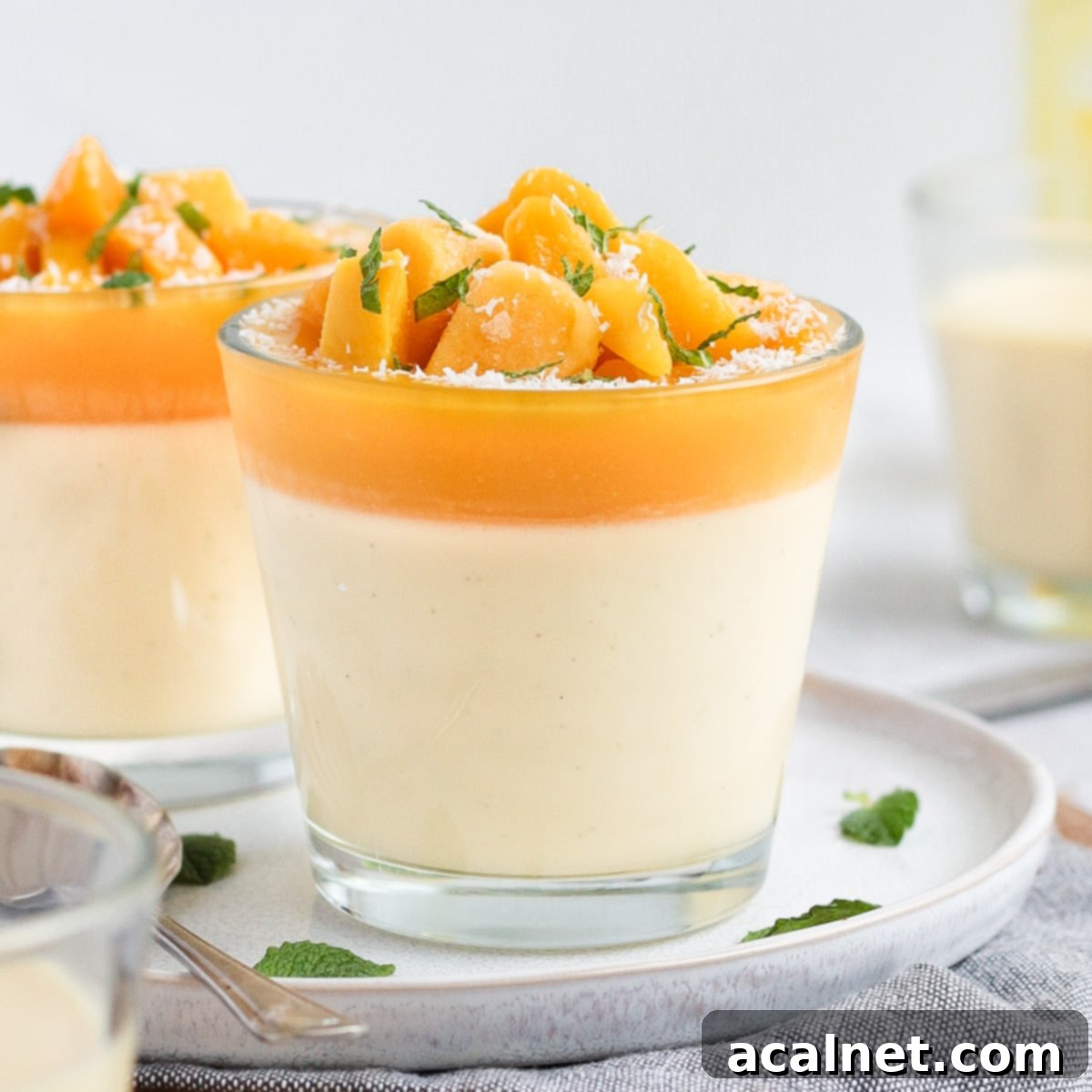Easy Double Mango Panna Cotta: The Ultimate Creamy Summer Dessert Recipe
This Double Mango Panna Cotta recipe is your ticket to the most exquisite and delightfully light summer dessert. Imagine a super creamy, intensely flavored panna cotta base, crowned with a vibrant mango coulis and fresh mango pieces. It’s not just delicious; it’s a fantastic make-ahead dessert, making it perfect for parties, barbecues, and any summer gathering where you want to impress with minimal last-minute fuss!
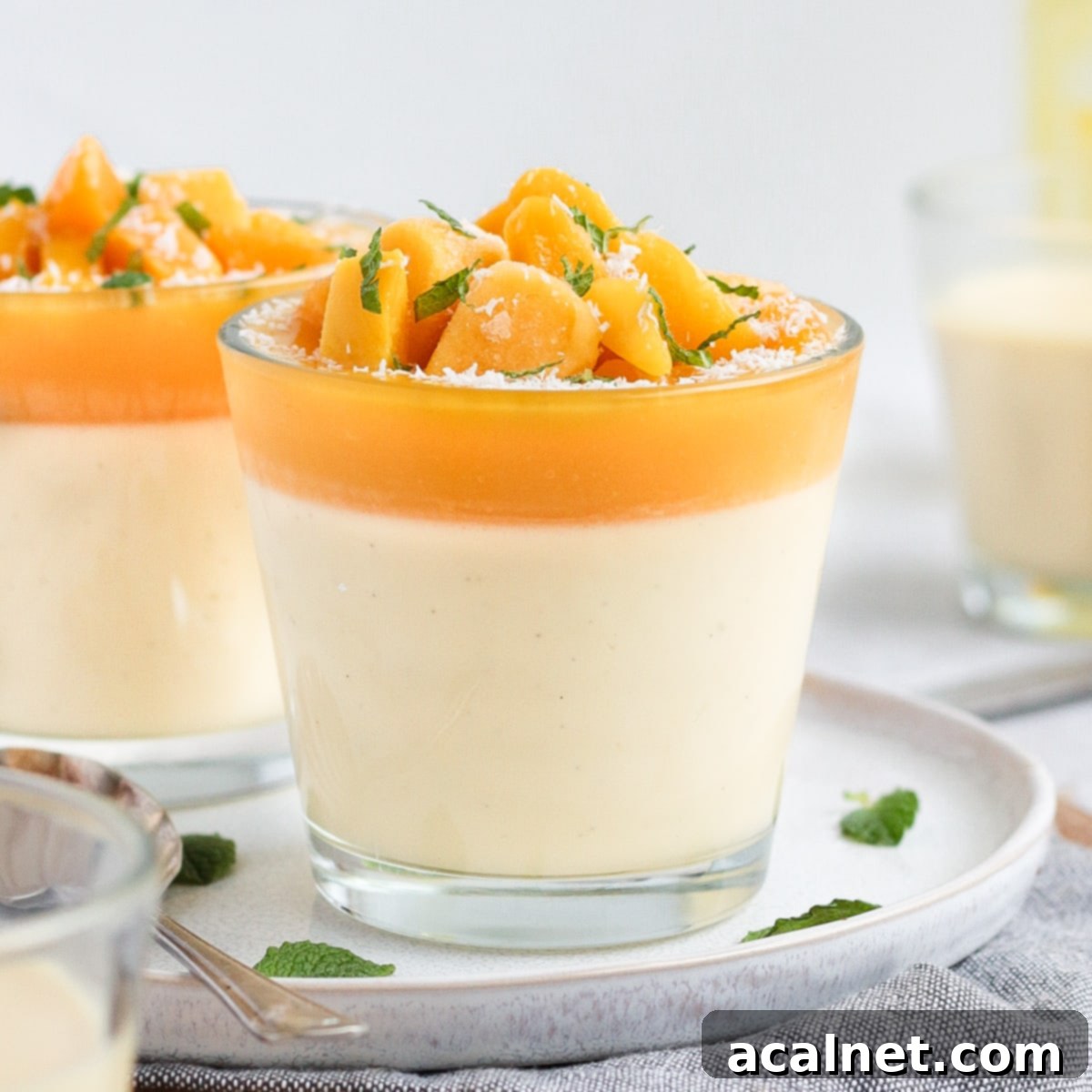
[feast_advanced_jump_to]
Why This Mango Panna Cotta Will Be Your New Favorite Summer Treat
If you’re searching for a dessert that embodies the essence of summer – light, fresh, and bursting with tropical flavor – look no further! This Mango Panna Cotta recipe is a true game-changer. It’s incredibly easy to prepare, making it accessible for home bakers of all skill levels, and the best part? It can be made entirely in advance, chilling in your fridge until you’re ready to serve. This means less stress on event days and more time enjoying your guests!
The star of this dessert is, of course, the sweet, succulent mango. We enhance its natural richness by combining it with a hint of fresh lime zest, which adds a bright, zesty counterpoint, and a touch of vanilla for a truly complex and irresistible flavor profile. The vibrant yellow hue alone is enough to brighten any table! To finish, a simple garnish of freshly sliced mango, a sprinkle of fresh mint, and a touch of desiccated coconut transforms this easy dessert into an elegant, party-ready showstopper.
Just like my popular No Bake Mango Cheesecake and other beloved panna cotta variations like Strawberry Panna Cotta, Coffee Panna Cotta, Chocolate Panna Cotta, and Raspberry Panna Cotta, this mango version is guaranteed to be a hit with everyone, from the pickiest eaters to the most discerning dessert connoisseurs. Its silky texture and refreshing taste make it the quintessential summer indulgence.
Essential Ingredients for Your Mango Panna Cotta
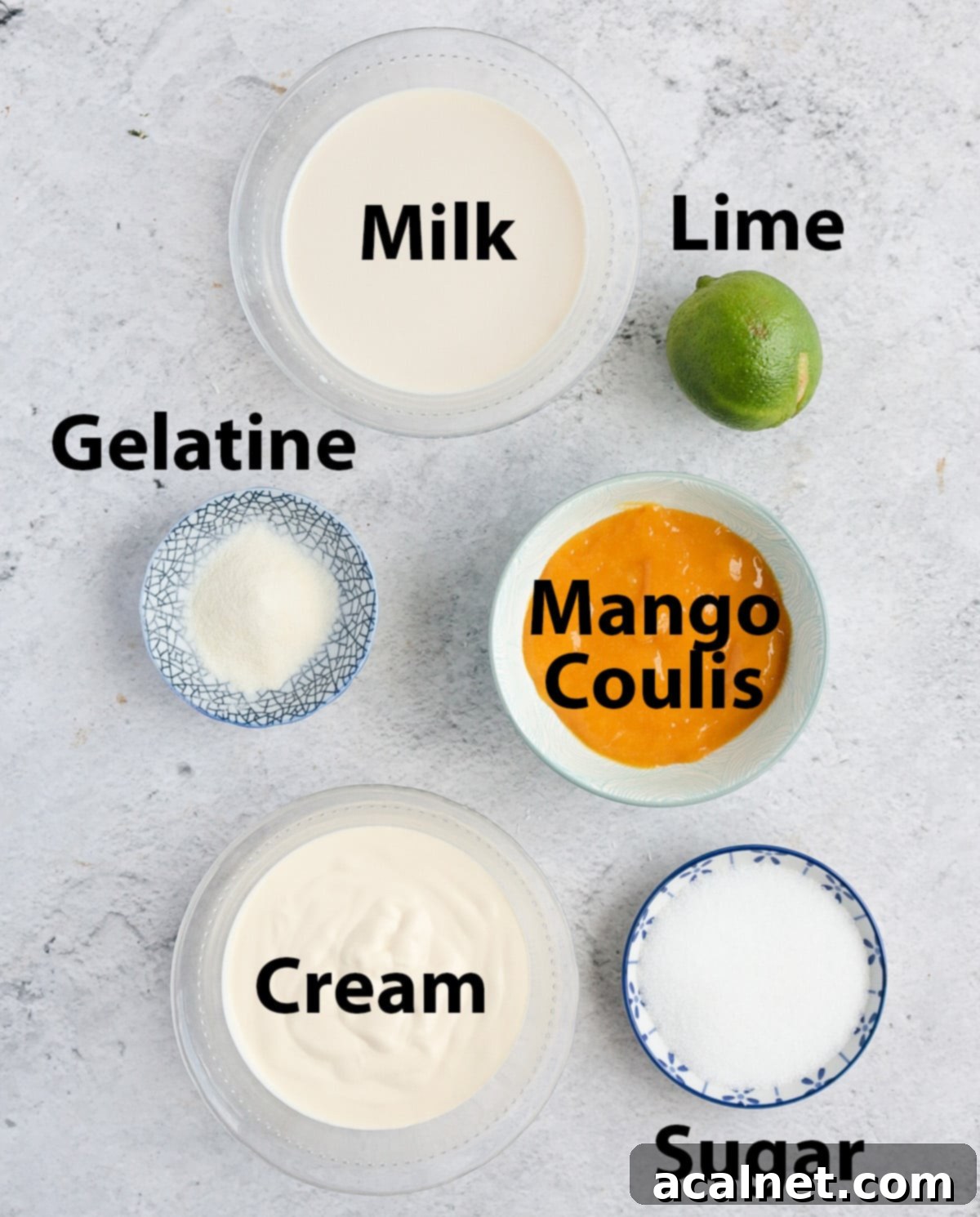
The beauty of panna cotta lies in its simplicity. At its core, it requires just a few basic ingredients: a liquid base (typically cream, milk, or a blend), a sweetener, and a gelling agent. For our luscious Mango Panna Cotta, we’ve elevated these basics with a burst of tropical flavor. You’ll need just six key ingredients (plus some optional enhancers) to create this exquisite dessert:
- Mango Coulis: This isn’t just a simple mango puree! Our coulis is a light, cooked mango sauce, expertly blended with sugar and lime juice to intensify the mango’s natural sweetness and add a zesty brightness. This pre-made element is crucial for that “double mango” flavor.
- Full Cream Milk + Heavy / Thickened Cream: While panna cotta can be made with solely milk for a lighter result, or solely cream for a richer one, our recipe strikes the perfect balance. The combination of full-cream milk and heavy (or thickened) cream creates a wonderfully light yet decadently rich texture that melts in your mouth without being overly heavy.
- Caster Sugar: Also known as superfine sugar, caster sugar dissolves quickly and evenly, ensuring a smooth, grit-free panna cotta. If you don’t have caster sugar, regular fine white granulated sugar will work just as well.
- Lime Zest: A vibrant addition that provides a burst of fresh, citrusy aroma and flavor. It beautifully complements the sweetness of the mango, preventing the dessert from becoming cloyingly sweet and adding an irresistible zing.
- Gelatine Powder: This is the essential gelling agent that gives panna cotta its signature silky, jiggly texture. It’s what transforms the creamy liquid into a set dessert that still retains a delightful melt-in-your-mouth quality.
- Vanilla Paste: While optional, a touch of vanilla paste (or extract) can significantly boost and round out the overall flavors of the dessert, adding a subtle warmth that harmonizes with the mango and lime. Don’t skip it if you want that extra layer of deliciousness!
Crafting Your Perfect Mango Panna Cotta: A Step-by-Step Guide
Making this delightful dessert involves two main stages: first, preparing the intensely flavorful Mango Coulis, and then assembling the creamy Panna Cotta base. The good news is, the coulis can be prepared up to a week in advance, streamlining your dessert-making process!
Step 1: The Flavorful Mango Coulis
As mentioned, our Mango Coulis is a thick, concentrated mango sauce. It’s made by gently cooking down fresh (or frozen) mango with a touch of lime juice and sugar, then blending until perfectly smooth. This process not only sweetens the mango but also develops its flavor, creating a more intense and shelf-stable sauce than a simple puree. This coulis can be stored in the fridge for up to a week, making it ideal for advance preparation.
You can find detailed instructions on how to make the easy mango coulis here. For this recipe, you will need a full batch of this vibrant sauce to ensure both the panna cotta base and the topping are rich with mango flavor.
Step 2: Assembling the Panna Cotta Cream
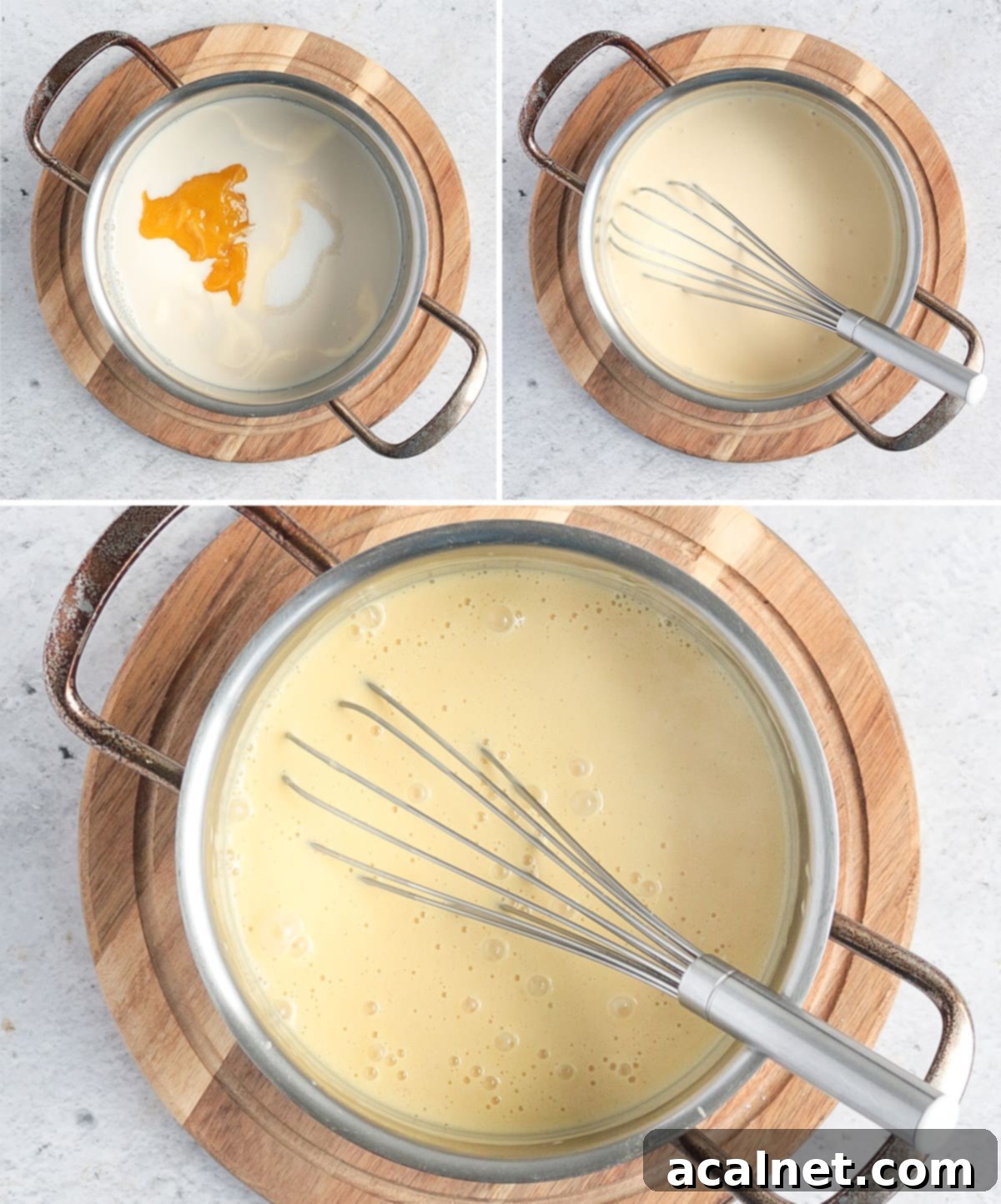
Once your luscious Mango Coulis is ready and perhaps chilled, it’s time to create the creamy panna cotta base:
- Combine the Liquids and Sweetener: In a small saucepan, combine the full cream milk, heavy cream, caster sugar, a measured portion of your prepared Mango Coulis, and the optional vanilla paste. Whisk these ingredients together thoroughly to ensure the sugar begins to dissolve and everything is well integrated.
- Gently Heat to a Simmer: Place the saucepan over low to medium heat on your stove. Heat the mixture gently, stirring occasionally, until it just reaches a simmer. You’ll see small bubbles forming around the edges of the pot. It’s crucial to stay attentive during this step, as milk and cream can boil over very quickly! As soon as it simmers, remove the pot from the heat to prevent scorching.
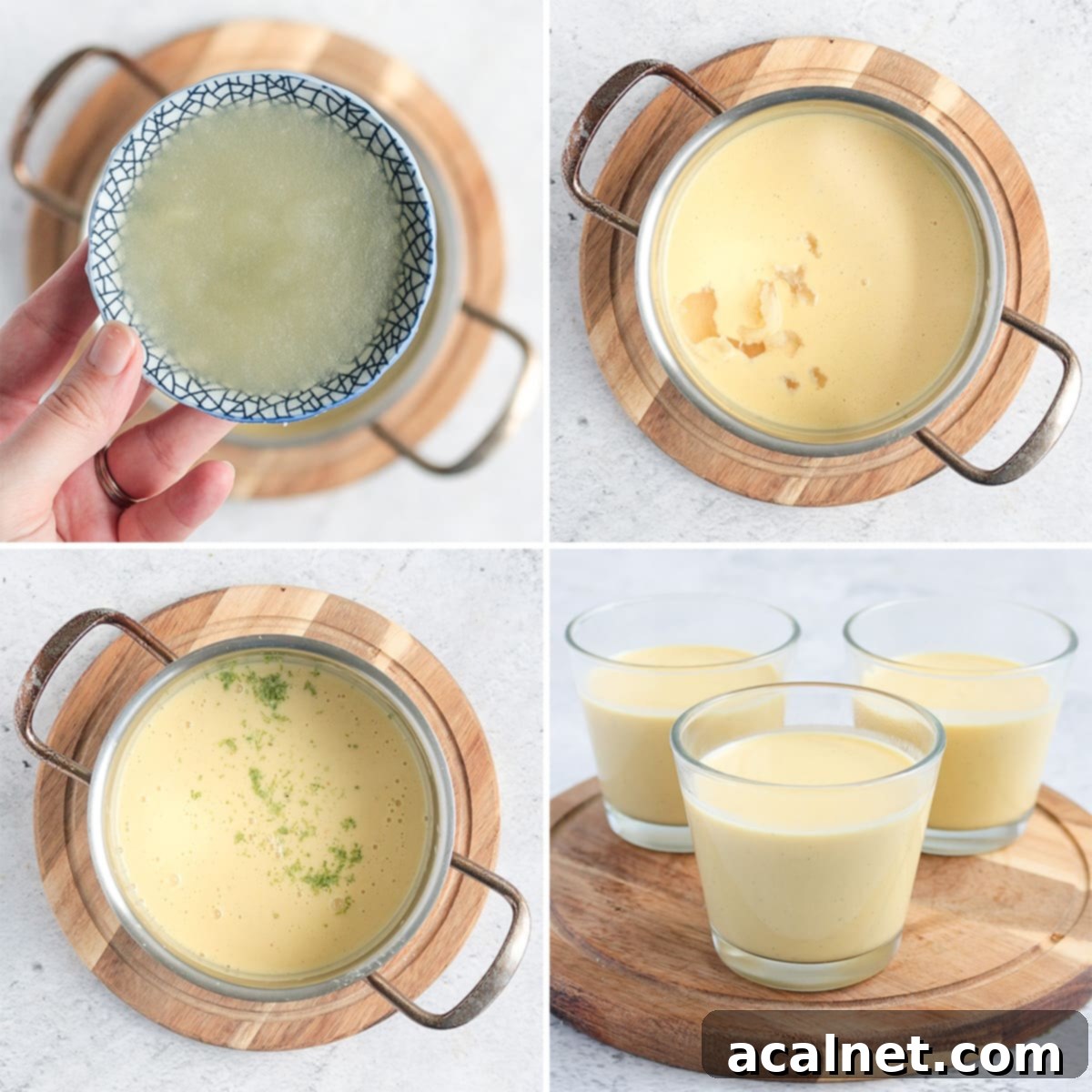
- Prepare the Gelatine: While the liquids are heating, place your gelatine powder in a small, separate bowl. Add a small amount of very cold water (typically 1-2 tablespoons for 2 teaspoons of gelatine powder) and whisk quickly until it forms a thick, lumpy paste. This “blooming” step is essential for the gelatine to dissolve smoothly without clumping when added to the hot liquid.
- Dissolve Gelatine and Add Flavor: Immediately after removing the pot from the heat, add the bloomed gelatine paste to the hot liquid mixture. Whisk vigorously for about a minute until the gelatine is completely melted and fully incorporated. Then, stir in the fresh lime zest. Adding the zest at this stage, off the heat, preserves its vibrant color and fresh aroma.
- Pour and Chill: Carefully pour the liquid panna cotta cream into your individual serving cups or ramekins. For ease, you might want to transfer the mixture to a measuring jug with a spout first. Once poured, cover each cup (to prevent them from absorbing fridge odors) and place them in the refrigerator. Allow at least 2 hours for the panna cotta to fully set, though chilling for 4 hours or overnight is even better for a perfectly firm texture.
Before serving:
- Once the panna cotta is completely set and firm, it’s time for the final touch. Generously spoon the remaining Mango Coulis over each individual panna cotta. Garnish with an array of fresh mango cubes, a few delicate fresh mint leaves for a pop of color and herbaceous note, and a light sprinkle of desiccated coconut for added texture and tropical flair. Serve immediately and enjoy!

Expert Tips for a Perfect Mango Panna Cotta Every Time
Achieving a restaurant-quality panna cotta at home is simpler than you think with these helpful tips:
- Customize Your Creaminess: The recipe uses a balanced mix of full cream milk and heavy cream for a light yet rich texture. If you prefer a lighter panna cotta, you can use all milk (though you might need a tiny bit more gelatine). For an extra decadent and rich dessert, substitute all the milk with heavy cream. Simply maintain the total liquid volume.
- Don’t Skip the Vanilla: While listed as optional, vanilla paste (or a good quality vanilla extract) is a fantastic flavor enhancer. It doesn’t just add its own sweet aroma; it also helps to deepen and bring out the natural sweetness of the mango and balance the tartness of the lime.
- Gentle Heat is Key: Always heat your liquid mixture over low to medium heat. High heat can cause the milk/cream to scorch on the bottom of the pan, or boil over rapidly, which is messy and can affect the flavor. Slow and steady wins the race here! Stay nearby and stir often as it approaches a simmer.
- Bloom Your Gelatine Properly: Dissolving gelatine powder in cold water first, a process known as “blooming,” is crucial. This step hydrates the gelatine, preventing it from clumping when added to hot liquids and ensuring it dissolves smoothly and evenly.
- Add Gelatine Off the Heat: Gelatine doesn’t need to boil to activate. In fact, boiling gelatine can reduce its gelling power. Always remove the saucepan from the heat before stirring in the bloomed gelatine paste. The residual heat from the simmering liquid is sufficient to melt it completely.
- Ensure Smooth Gelatine Incorporation: After adding the gelatine, whisk the mixture thoroughly until no lumps remain. For an ultra-smooth consistency and to be absolutely sure the gelatine is fully melted, you can use an immersion blender for a quick whiz.
- Preserve Lime Zest Freshness: Add the lime zest at the very end, once the mixture is off the heat. This prevents the zest from “cooking” and turning brown, allowing it to retain its vibrant green color and fresh, aromatic oils for the best flavor.
- Easy Pouring and Setting: To make pouring the liquid panna cotta into individual cups less messy, transfer the mixture into a measuring jug with a spout first. If you prefer to unmold your panna cotta, consider setting it in individual silicone molds or lightly greased ramekins instead of cups.
- Chill Until Fully Set: Patience is a virtue here! Ensure your Mango Panna Cottas are completely set and firm before you add the final layer of mango coulis and other toppings. This guarantees beautiful, distinct layers and prevents the coulis from sinking into the panna cotta.
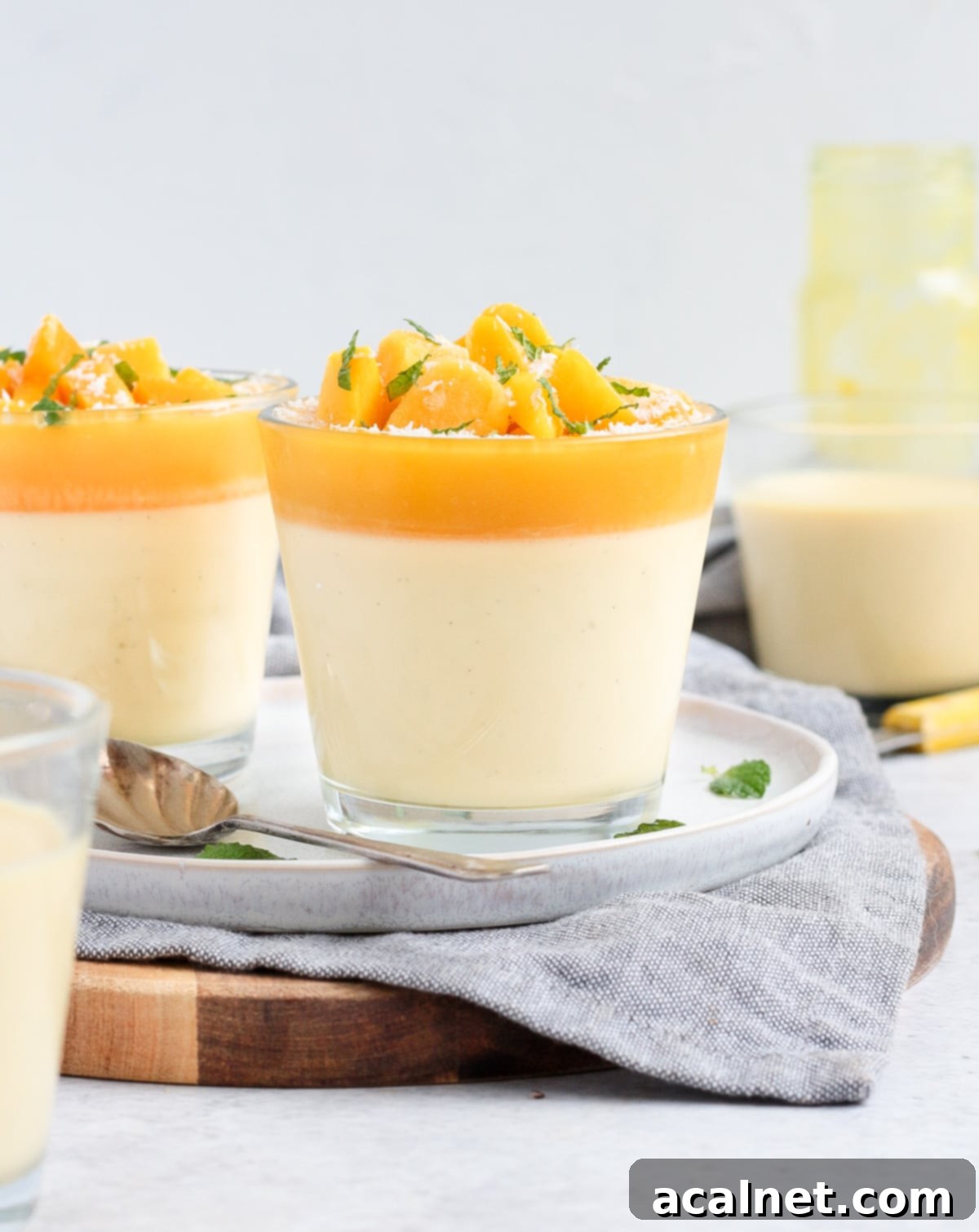
Frequently Asked Questions About Mango Panna Cotta
While you absolutely can use a simple homemade mango puree for convenience, I highly recommend opting for the Mango Coulis for this recipe. The key difference lies in the flavor and consistency. Our coulis is gently cooked with sugar and lime juice, which concentrates the mango flavor, brightens it, and creates a slightly thicker, more stable sauce. A simple puree (just blended mango) will be less intensely flavored and much more liquid, meaning the top layer of your panna cotta might not be as thick and luscious as intended. Alternatively, for an even richer and tangier option, you could consider my Mango Curd recipe.
If you opt for a quick homemade puree, simply blend about 500 grams (approximately 1 pound) of fresh or thawed frozen mangoes until completely smooth. Remember that without the added sugar and lime juice, you might want to adjust the sweetness and tartness to your liking in the panna cotta base.
Absolutely! Panna cotta is wonderfully versatile and lends itself beautifully to dairy-free and vegan adaptations. The creamy base can be achieved with various plant-based alternatives.
To make this recipe Dairy-Free, simply substitute the full cream milk with your favorite dairy-free milk (such as almond milk, soy milk, or oat milk) and replace the heavy cream with a plant-based cream like full-fat coconut cream or soy cream. For an outstanding flavor profile that perfectly complements the tropical mango, I highly recommend using a combination of full-fat coconut milk and coconut cream – the flavors are simply divine together!
For a fully Vegan alternative, you will also need to replace the gelatine with a plant-based gelling agent. Read the next FAQ for details on using Agar-Agar.
Yes, you certainly can! For a vegan option or simply to avoid animal-derived gelatine, Agar Agar powder is an excellent plant-based alternative. Derived from algae, agar agar creates a firm, jelly-like texture. It’s important to note that agar agar works differently than gelatine; it requires boiling to activate its gelling properties, which means a direct 1:1 substitution isn’t always possible in every recipe.
Fortunately, panna cotta is one of those recipes where agar agar works perfectly as a substitute because we already heat the liquids. Be mindful of the quantities, as agar agar has a much stronger gelling power than gelatine. For this recipe, you will need to replace the 7 grams (2 teaspoons) of gelatine powder with approximately 3/4 teaspoon of Agar Agar powder (or about 1.5 grams). This conversion is similar to how I prepared my Vegan Coconut Panna Cotta.
The process for incorporating agar agar will also differ slightly: instead of blooming the gelatine in cold water, you will add the agar agar powder directly to the milk, cream, sugar, and mango coulis mixture. Bring this mixture to a full boil, then whisk vigorously for about 2 minutes to ensure the agar agar is fully dissolved and activated before removing from the heat and continuing with the recipe.
Storing Your Delicious Mango Panna Cotta
Proper storage ensures your panna cotta remains fresh, flavorful, and perfectly set for your enjoyment.
How to Keep the Dessert Fresh
The Mango Coulis is quite robust! Once prepared, it can be stored in an airtight jar or container in the refrigerator for up to a week. For longer storage, it freezes beautifully for several months, ready to be thawed and used whenever you desire.
The Panna Cotta itself should always be stored in the fridge. Make sure to cover each individual serving cup tightly with plastic wrap to prevent them from absorbing any unwanted odors from other foods in your refrigerator and to maintain their moisture. Enjoy within two days for the best taste and texture.
For optimal freshness and presentation, I strongly recommend adding the final layer of mango coulis and any chosen toppings (fresh mango, mint, coconut) just before you’re ready to serve. This ensures the toppings are vibrant and crisp.
Can I make it in advance?
Absolutely! This Mango Panna Cotta is an ideal make-ahead dessert, which is one of its most appealing features, especially when entertaining. As mentioned, the Mango Coulis can be prepared up to a week ahead of time. The panna cotta base can be made and chilled in the fridge for up to two days before serving.
For the freshest taste and perfect texture, I recommend assembling the panna cotta up to 24 hours in advance. Remember to hold off on adding the final mango coulis topping and garnishes until just before you’re ready to present and serve it!
Can I freeze Panna Cotta?
While the homemade Mango Coulis is perfectly freezer-friendly and can be stored for later use, the panna cotta itself does not freeze well. The delicate emulsion of the cream and the structure formed by the gelatine can break down during freezing and thawing, resulting in a watery, grainy, or separated texture. It’s best enjoyed fresh from the refrigerator within the recommended storage time.
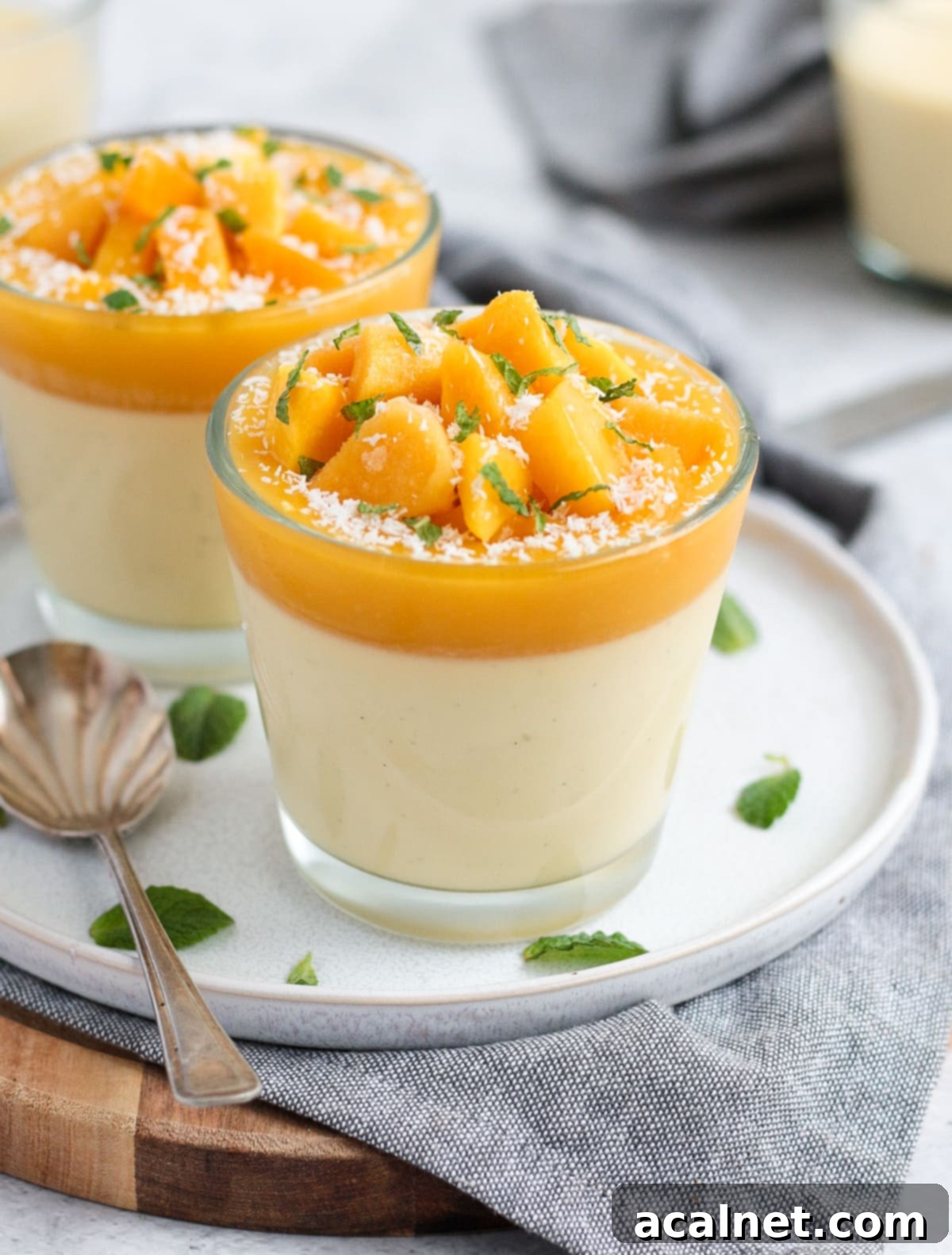
Explore More Refreshing Summer Desserts
If you’re loving the light and fruity vibes of this Mango Panna Cotta, be sure to check out these other delightful summer recipes that are perfect for warm weather entertaining:
- Banana Chia Seed Puddings
- Fresh Apricot Crumble with Oat Topping
- Easy Double Raspberry Mousse Cups
- Simple Cherry Clafoutis
- Easy Peach Galette with Almonds
- Luscious Mango Mousse Cake
Made this recipe?
Let us know if you liked it by leaving a comment below, and tag us on Instagram @a.baking.journey with a photo of your creation! We love seeing your delicious results!
Full Mango Panna Cotta Recipe
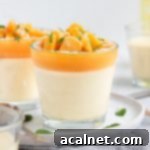
Mango Panna Cotta
Print Recipe
Ingredients
For the Mango Coulis (see note 1)
- 400 grams Mango Flesh, fresh or frozen, diced
- 30 ml Fresh Lime Juice
- 30 grams Caster Sugar
For the Mango Panna Cotta Base
- 250 ml Full Cream / Whole Milk
- 250 ml Thickened / Heavy Cream
- 40 grams Caster Sugar
- 180 ml Mango Coulis, from the coulis prepared in step one
- 1/2 teaspoon Vanilla Paste, optional, or extract
- 7 grams Gelatine Powder, + 1-2 tablespoons cold water for blooming
- 1/2 teaspoon Fresh Lime Zest
For Toppings (Optional, to taste)
- Remaining Mango Coulis, for layering
- Fresh Mango Cubes, Fresh Mint Leaves, Desiccated Coconut, for garnish
Instructions
Prepare the Mango Coulis
- First, prepare your Mango Coulis. Follow these detailed instructions, using the specified quantities above. This can be done up to a week in advance and stored in the fridge, or even frozen for longer. Refer to Note 1 if you plan to substitute with plain mango puree.
Prepare the Mango Panna Cotta Base
- In a small saucepan, combine the Full Cream Milk, Heavy Cream, Caster Sugar, 180 ml of your prepared Mango Coulis, and the Vanilla Paste (if using). Whisk all ingredients well to combine. Place the saucepan on the stove over low to medium heat and gently heat until the mixture just starts to simmer around the edges (see Note 2 for important tips on heating). Immediately remove from the heat.
- While the cream mixture is heating, prepare the gelatine. In a small bowl, add the Gelatine Powder and whisk in 1 to 2 tablespoons of cold water until it forms a thick, lumpy paste. This is known as blooming the gelatine (see Note 3 for more detail).
- Once the cream mixture has been removed from the stove, add the bloomed Gelatine paste to the hot liquid. Whisk vigorously for about 1 minute until the gelatine is completely dissolved and no lumps remain.
- Stir in the Fresh Lime Zest. Ensure it’s well combined.
- Carefully pour the liquid panna cotta mixture into individual serving cups or ramekins. Place these in the fridge to cool down and set for a minimum of 2 hours, or until completely firm (see Note 4 for chilling tips). For the best results, chill for at least 4 hours or overnight.
Garnish and Serve
- Just before serving, spoon the rest of the vibrant Mango Coulis over each set panna cotta. Make sure the panna cottas are completely firm before adding this layer to achieve clean lines.
- Optional: For a stunning finish, garnish each dessert with fresh mango cubes, a few sprigs of fresh mint, and a sprinkle of desiccated coconut, to taste. Serve chilled and enjoy!
Would you like to save this recipe?
We’ll email this post to you, so you can come back to it later!
Notes
- Mango Coulis vs. Puree: While you can use about 500 grams (1 pound) of blended fresh or thawed mango puree as a substitute, note that the resulting mango layer will not be as thick or as intensely flavored as with the prepared Mango Coulis. The coulis process enhances both flavor and texture.
- Heating the Cream Mixture: It’s crucial to stay close to the stove and stir occasionally when heating the milk and cream mixture. Dairy products can boil over and scorch very quickly if left unattended, potentially ruining the flavor and texture of your panna cotta.
- Blooming Gelatine: The amount of cold water needed to bloom gelatine powder can vary slightly depending on the brand. The goal is to create a thick, lumpy paste, not a watery mixture. Approximately 1-2 tablespoons for 7 grams of gelatine powder is a good starting point.
- Chilling and Covering: Always cover your individual panna cotta cups tightly with plastic wrap before refrigerating. This prevents the panna cottas from absorbing any unwanted odors from other foods in the fridge and helps maintain their moisture, ensuring a smooth, delicious result. For best results, allow at least 4 hours for setting, or preferably overnight.
Nutrition (per serving)
